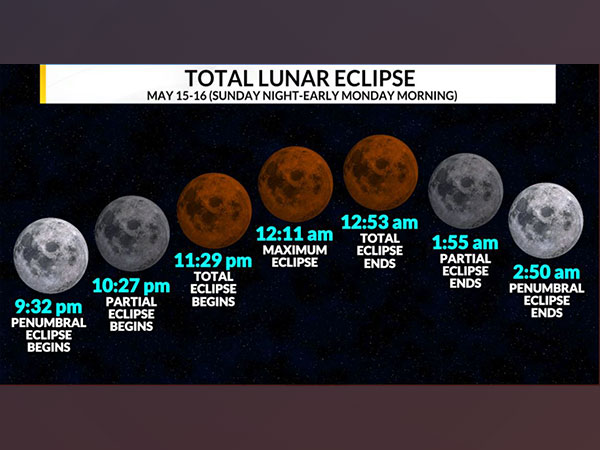New Delhi [India]: North American Sky gazers can see the moon take on a reddish tint on the night of May 15-16.
Almost a year after the last total lunar eclipse, the sight of the moon sliding into the shadows of the Earth returns and graces the sky.
Viewers of most North America, all of Latin America, Western Europe, most of Africa, and the East Pacific will see the Moon darken and acquire a reddish hue from the late evening of May 15 into the early hours of May 16.
The Moon charts a course via the southern half of Earth’s shadow and is expected to ultimate for eighty-five minutes. Mid-eclipse will occur on May 16 (4:12 Universal Time), approximately 1 1/2 days earlier than the Moon reaches perigee, the point in its orbit when it’s closest to the Earth. On eclipse night, the Moon will seem around 12 per cent larger than it does when it’s at apogee (farthest from Earth in its orbit). However, the most committed Moon watchers will observe this in all likelihood. The May 15-16 eclipse could be a fairly dark one but look for a bit of brightening along the Moon’s southern limb.
Viewers may have the possibility to see the summer Milky Way glowing nicely during totality as the overwhelming brightness of the full Moon is dimmed by Earth’s shadow.
The stages of the eclipse occur simultaneously for everyone, but not everyone will see the full eclipse. Weather permitting, observers in the eastern half of North America will witness the entirety of the event starting on the evening of May 15, with the partial eclipse phase beginning about two hours after sunset for the East Coast and around one hour after sunset for the Midwest. The Moon will be about to enter totality on the West Coast as it rises around sunset. And in the Northwest, the Moon rises as the later stages of the eclipse are already underway. Most of Alaska will have to sit this one out, though.
South America will see the whole show, starting on the evening of May 15, while viewers in western Europe and Africa will have to set their alarms to enjoy the event in the hours before dawn on May 16. For observers in the British Isles, the Moon sets as it’s fully immersed in Earth’s dark, inner shadow, whereas viewers in New Zealand will catch the tail end of the event on the evening of May 16, as the Moon rises while it’s exiting Earth’s shadow.
Mechanics of a Lunar Eclipse
“A lunar eclipse happens when the Sun, Earth, and a full Moon form a near-perfect lineup in space, in what is known as syzygy,” says Diana Hannikainen, Observing Editor at Sky & Telescope. The Moon slides into Earth’s shadow, gradually darkening until the entire lunar disk turns from silvery grey to an eerie dim orange or red. Then events unfold in reverse order until the Moon returns to full brilliance. The whole process for the May 16 eclipse will take about five hours and 20 minutes.
The event has five stages, each with different things to watch.
(1) The Moon’s leading edge enters the pale outer fringe of Earth’s shadow: the penumbra. You probably won’t notice anything until the Moon is about halfway across the penumbra.
The penumbra is the region where an astronaut standing on the Moon would see Earth covering only part of the Sun’s face.
(2) The Moon’s leading edge enters the umbra, the cone of Earth’s shadow within which the Sun’s completely hidden. You should notice a dramatic darkening on the leading edge of the lunar disk. With a telescope, you can watch the edge of the umbra slowly engulfing one lunar feature after another as the entire sky begins to grow darker.
(3) The trailing edge of the Moon slips into the umbra for the beginning of the total eclipse. But the Moon won’t blackout completely: It’s sure to glow some shade of intense orange or red.
Why is this? The Earth’s atmosphere scatters and bends (refracts) sunlight that skims its edges, diverting some of it onto the eclipsed Moon. It’s the same effect that happens at sunset. If you were on the Moon during a lunar eclipse, you’d see the Sun hidden by a dark Earth rimmed with the reddish light of all the sunrises and sunsets ringing the world at that moment.
The red umbral glow can be quite different from one eclipse to the next. Two main factors affect its brightness and hue. The first is simply how deeply the Moon goes into the umbra as it passes through; the centre of the umbra is darker than its edges. The other factor is the state of Earth’s atmosphere. If a major volcanic eruption has recently polluted the stratosphere with thin global haze, a lunar eclipse can be dark red, ashen brown, or occasionally almost black.
In addition, blue light is refracted through Earth’s clear, ozone-rich upper atmosphere above the thicker layers that produce the red sunrise-sunset colours. This ozone-blue light also tints the Moon near the umbra’s edge. You’ll need binoculars or a telescope to see this effect.
(4) As the Moon continues moving along its orbit, events replay in reverse order. The Moon’s edge re-emerges into the sunlight, ending totality and beginning a partial eclipse again.
(5) When all of the Moon escapes the umbra, only the last, penumbral shading is left. Sometime later, nothing unusual remains.
(6) As the moon moves further along the orbit, the events will play in reverse order. The lunar limbs reappear in the sun, ending with a total solar eclipse and starting again with a partial solar eclipse.
(7) When the entire moon leaves the umbrella, only the last shade of the penumbra remains. After a while, nothing unusual remains. (ANI)




















Comments